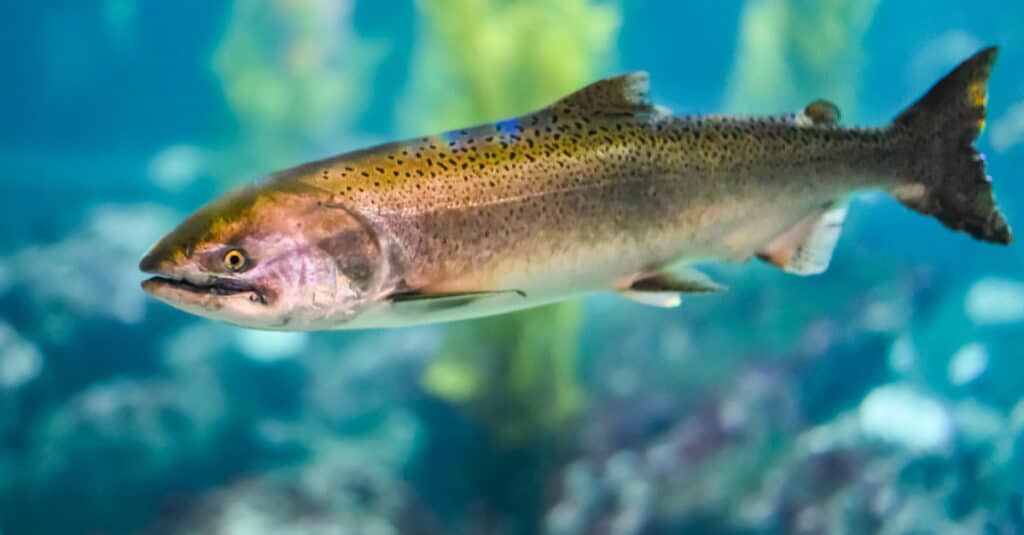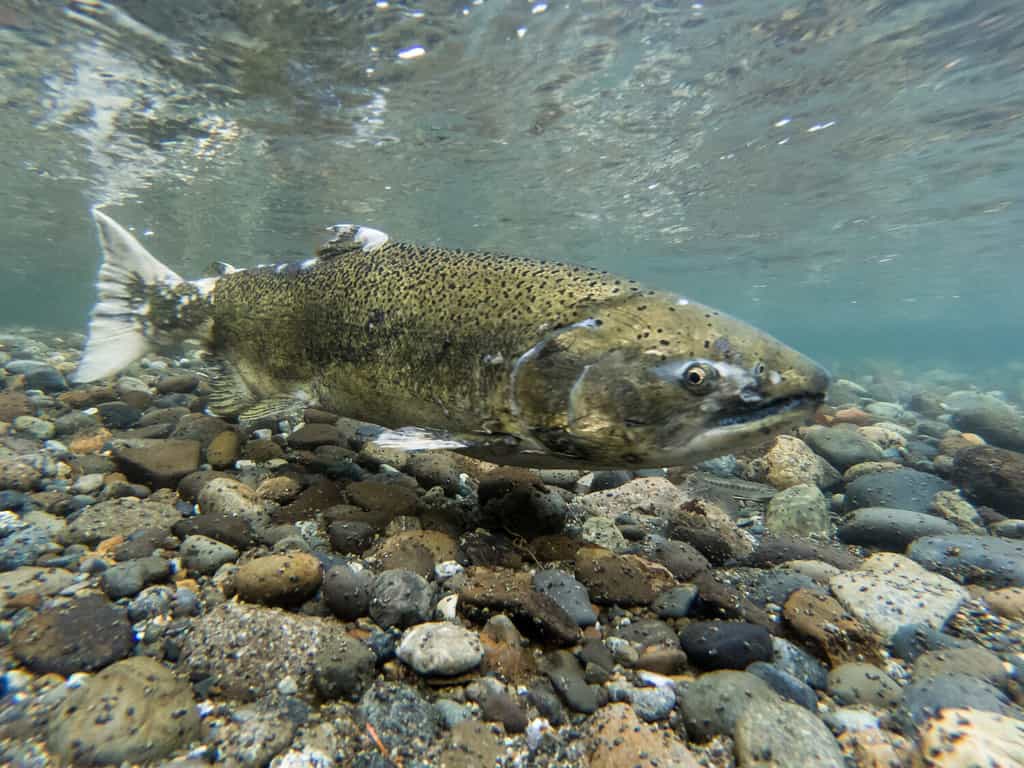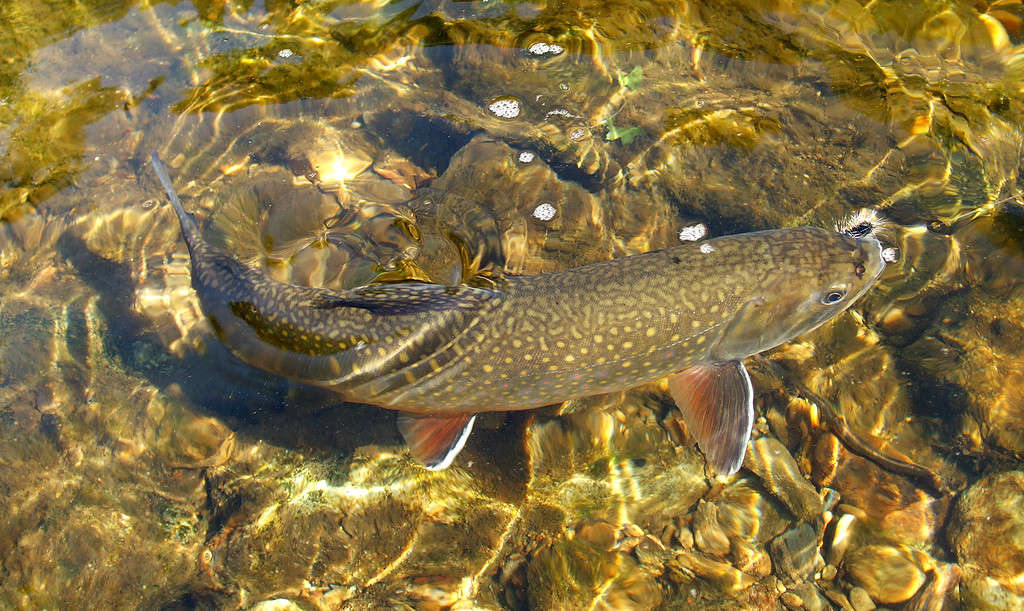
An enigmatic world of aquatic monsters stirs beneath the surface as the sun casts its golden rays upon the Klamath River. Like ancient titans of mythology, these colossal fish species have claimed the depths as their dominion.
The Klamath river, carving its path through Oregon and California, holds the key to unlocking the mysteries of these river monsters. Prepare for a thrilling adventure as we delve into the lives and legends of the six largest fish that call this serpentine waterway home.

Picture yourself standing at the water’s edge, peering into the realm of these underwater giants; with every ripple and splash, a new story unfolds, revealing the secrets of these elusive creatures. From the sturgeon to the mighty Chinook salmon, each fish has a tale as unique as their size.
Join us on this captivating journey as we navigate the twists and turns of the Klamath River, unearthing the wonders of its most extraordinary inhabitants.
1. Steelhead
The Klamath River is home to one of the largest fish species, the steelhead. In the early season, from fall to early winter, the lower stretch offers the best fishing opportunities, easily accessible by jet boats or wading.

The lower stretch of the Klamath River offers the best vantage point for fishing steelhead trout.
©David A Litman/Shutterstock.com
Swinging flies is popular among anglers, drawing out steelhead from the lower Klamath River. As fall approaches, the middle section becomes a hot spot for steelhead fishing, boasting abundant shore access and ideal conditions for wading.
However, the latter part of the run truly excites local anglers. Steelhead migrates to the upper Klamath River between November and February, creating a bonanza below the Iron Gate Dam. Drifting nymphs and using salmon roe or egg imitations prove highly effective, particularly for winter-run steelhead.
While the Klamath River is known more for steelhead abundance than size, “half-pounders” (14-20 inches) are the most common catch. These juvenile steelheads provide great sport on a 9-foot, 5-weight fly rod. Adult steelhead in the 5-7 pound range is also caught, with a few 10-pounders landed each year, renowned for their incredible fight and aerial acrobatics.
2. Chinook Salmon
Chinook salmon, known as the monster of the Klamath River, is one of the largest fish species in the area. They spend their lives in the Pacific Ocean and make annual spawning runs upstream.
Although Chinook salmon populations fluctuate, they display impressive size and fierce fighting abilities. Anglers can typically expect to catch 10 to 15 pound fish, with some reaching 20 to 30 pounds.

The Klamath River hosts both fall and spring Chinook salmon runs.
©Kevin Cass/Shutterstock.com
The Klamath River hosts both spring and fall salmon runs. The spring run proves more challenging for anglers, often requiring a day’s wait for just one bite. However, the largest fish are usually caught between April and June, when regulations permit.
In contrast, the fall run begins in August and peaks in October. During this time, Chinook salmon aggressively swim upstream, striking baits out of sheer aggression. By September, the area in the middle of Klamath between Orleans and Happy Camp becomes a prime fishing spot.
Anglers target Chinook salmon by back-trolling wobbling plugs or drifting roe and spoons in deep pools. Bank access is readily available in this section of the river. The Iron Gate Dam marks the end of the journey for salmon, as it does for steelhead.
In October, the final 9 miles of the Klamath River from the I-5 bridge up to the dam provide incredible fishing opportunities. While many salmon ventures into the Klamath’s tributaries, those that remain end up in the tailrace below the dam.
3. Green Sturgeon
The Klamath River houses the green sturgeon, a truly massive fish. These giants can reach lengths of 7.5 feet, standing out among other species. Additionally, they weigh up to an astonishing 350 pounds.
Green sturgeons display a unique greenish hue on their bodies. Their elongated snouts and vacuum-like mouths aid in feeding. They scour the riverbed for nourishment, maintaining their impressive size.

Green sturgeon can reach lengths of 7.5 feet and weigh up to 350 pounds.
©Kletr/Shutterstock.com
Fascinatingly, these creatures live for around 70 years. However, females take 15-20 years to reach maturity. Moreover, they reproduce only every three to five years, adding to their rarity.
Unfortunately, green sturgeons face multiple threats. Overfishing and habitat loss contribute to dwindling numbers. Consequently, conservation measures are necessary to protect these magnificent beings.
4. Pacific Lamprey
The Pacific lamprey is one of the Klamath River’s largest fish. These fascinating creatures have eel-like bodies, reaching lengths of up to 30 inches. Additionally, their circular, jawless mouths make them truly unique in appearance.

The Pacific lamprey is the Klamath River’s largest fish, with an eel-like body and jawless, circular mouths.
©iStock.com/randimal
Beginning their life cycle in freshwater, Pacific lampreys undergo an incredible transformation. After a few years, they migrate to the ocean, where they mature and grow. Eventually, these fish return to their native rivers to spawn and complete their life cycle.
Pacific lampreys play a vital role in the Klamath River ecosystem. They serve as a crucial food source for predators, including birds and marine mammals. Moreover, their presence benefits the local fishing industry by attracting larger fish species.
Conservation efforts have been put into place to protect these essential fish. Agencies are working together to monitor populations and improve habitat conditions. By restoring river health and ensuring safe passage, we can preserve the Pacific lamprey and its essential contributions to the Klamath River ecosystem.
5. Trout
Trout, one of the largest fish in the Klamath River, often goes underappreciated. Many visitors focus on the famous steelhead and salmon runs instead. However, trout fishing in the Klamath River, especially wild rainbow and brown trout, deserves attention.
The upper Klamath River offers an ideal location for trout fishing. The river narrows here, making it more suitable for wading and fly-fishing. Mid-May through early July is the best time to fish for trout, as it coincides with a significant hatch and a lull in salmon and steelhead activity.

Mid-May to early July offers prime time for trout angling.
©iStock.com/Coast-to-Coast
Stoneflies emerge in large numbers in the upper Klamath River during late spring and early summer. Dry flies imitating these insects increase the chances of catching feisty trout. Two prominent species, the salmon fly and golden stonefly, are widespread, so prepare your fly box accordingly.
Using nymphing with a strike indicator can also be effective during insect emergence. Trout often gather in riffles and under overhanging trees along the banks, waiting to feast. The Klamath River’s excellent trout fly-fishing upriver and robust steelhead runs downriver make it a top choice among California’s best fly-fishing rivers.
By mid-to-late July, the water in most parts of the Klamath River is too warm for fishing. As a result, anglers shift their focus downstream again, anticipating the arrival of fall salmon and steelhead at the river’s mouth.
6. Klamath River Sucker (Lost River sucker)
The Klamath River boasts a large fish species, the Lost River sucker. This remarkable fish can reach up to two and a half feet long, outgrowing other Klamath suckers. On the other hand, the more petite shortnose sucker measures around twenty-one inches.
Since the 1990s, these fish have struggled to survive, with most failing to reach adulthood. High mortality rates during their early years pose significant challenges. Contributing factors include substandard water quality, diseases exacerbated by increasing water temperatures, and diminishing wetland habitats that supply crucial food and protection.

Klamath suckers are easily recognizable by their unique submarine-shaped bodies adorned in silvery-to-olive-green or brown-to-orange hues.
©USFWS Pacific Southwest Region / Flickr – License
From 2001 to 2020, the adult populations of endangered shortnose and Lost River suckers in Upper Klamath Lake saw a sharp decrease, ranging between 65 and 85 percent. Consequently, extinction is becoming a real possibility for these species unless efforts are made to restore their populations. To address this issue, the Klamath Tribes, the U.S. government, the State of Oregon, and various nonprofits are collaborating to avert sucker extinction in the Klamath Basin.
Klamath suckers are easily recognizable by their unique submarine-shaped bodies adorned in silvery-to-olive-green or brown-to-orange hues. Dark blotchy patches gradually fade to white on their underside. Additionally, they have blunt heads and bumpy lips that protrude downward.
These fish usually reside in lakes and travel to shoreline springs or tributaries for spawning. After hatching, the larvae quickly move to lakes, where they mature as early as four years of age. They proceed to spawn yearly and generally live into their late twenties, with a few surviving into their thirties.
Threats to the Klamath River’s Fish Populations
The Klamath River has some big fish monsters. Regrettably, these remarkable creatures face multiple threats, such as pollution, dams, water diversion, and overfishing, affecting the river’s fish populations.
- Pollution wreaks havoc on fish and their habitats. Harmful chemicals infiltrate the river through agricultural and industrial runoff, causing oxygen depletion and toxic algal blooms. Moreover, dams pose a significant threat by obstructing migration routes and barring access to spawning grounds. Consequently, water diversion for irrigation diminishes the water available for fish, leading to decreased habitat quality and reduced food supply.
- Overfishing also plagues the Klamath River’s fish populations. Excessive fishing results in population decline due to hindered reproductive success or elevated mortality rates. Additionally, fishing gear inflicts physical damage on important habitats like coral reefs or seagrass beds, which serve as nursery grounds for juvenile fish species.
Pollution, dams, water diversion, and overfishing threaten the extraordinary aquatic ecosystem and diverse species of the Klamath River. Collaborative efforts are essential to conserving this precious resource for future generations, allowing them to relish its splendor and abundance for years.
Conservation Efforts and Success Stories
The Pacific Northwest’s largest fish call the Klamath River their home. Local, state, and federal initiatives were established to protect and restore the fish populations.
Successful conservation efforts have been made possible through collaboration between the Refuge and the Klamath Tribes. The achievement led to modifications of fish passage barriers, invasive species removal, and sediment stabilization.
The Nature Conservancy’s project in the Lower Klamath Basin is another success story where critical spawning and rearing habitats were restored for salmon and steelhead. This project has revived one of the most significant salmon runs on the Pacific coast.
RES is leading a massive restoration effort to remove the Klamath dams in 2023 and 2024, marking the most extensive dam removal and river restoration project in U.S. history.
Community involvement is also integral to conservation efforts. Western Rivers Conservancy and Yurok Tribe collaborate to protect 47,000+ acres of temperate rainforest along the Klamath River.

The Klamath River is home to the Pacific Northwest’s largest fish.
©randy andy/Shutterstock.com
The Importance of Protecting River Monsters
Undoubtedly, protecting river monsters plays a vital role in maintaining the biodiversity of the Klamath River. These enormous fish, the largest species inhabiting the river, contribute significantly to the ecosystem. Hence, preserving their population is essential.
- River monsters serve as a crucial link within the food chain. They prey on smaller fish, maintaining balance in aquatic life. In turn, larger predators rely on these monsters for sustenance. Consequently, their protection ensures stability in the river’s ecosystem.
- Moreover, river monsters hold cultural significance for local communities. For generations, they have been part of folklore and traditions. Indeed, safeguarding these creatures preserves the rich heritage of people residing near the Klamath River.
- Additionally, the presence of these sizable fish attracts tourists and researchers alike. As a result, ecotourism flourishes, fostering economic growth for the region. Simultaneously, scientists gain valuable insights into these fascinating species, furthering our understanding of aquatic life.
- River monsters act as indicators of environmental health. A thriving population signifies a healthy river, while a decline may signal pollution or habitat destruction. Thus, monitoring their numbers helps us assess and address potential threats to the ecosystem.
Reeling in the Secrets of Klamath’s Aquatic Giants
The Klamath River showcases a fascinating assortment of colossal aquatic inhabitants that never cease to amaze anglers and nature lovers alike. These impressive river monsters are vital to the river’s rich ecosystem and emphasize the significance of conserving our natural environment for future generations to appreciate. Exploring the Klamath River offers a unique opportunity to witness these aquatic marvels’ remarkable diversity and size, making it an unforgettable experience for all who venture into its waters.
As we explore and learn about these behemoths, we gain a deeper understanding of the incredible biodiversity found within Earth’s waterways and their essential role in supporting life on our planet.
The photo featured at the top of this post is © Brenda Miroslav/Shutterstock.com
Thank you for reading! Have some feedback for us? Contact the AZ Animals editorial team.






